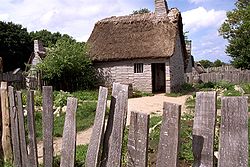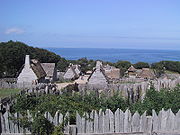
Plimoth Plantation
Encyclopedia


Living museum
A living museum is a type of museum, in which historical events showing the life in ancient times are performed, especially in ethnographic or historical views, or processes for producing a commercial product in terms of technical and technological developments are shown, especially the craft...
in Plymouth, Massachusetts
Massachusetts
The Commonwealth of Massachusetts is a state in the New England region of the northeastern United States of America. It is bordered by Rhode Island and Connecticut to the south, New York to the west, and Vermont and New Hampshire to the north; at its east lies the Atlantic Ocean. As of the 2010...
that shows the original settlement of the Plymouth Colony
Plymouth Colony
Plymouth Colony was an English colonial venture in North America from 1620 to 1691. The first settlement of the Plymouth Colony was at New Plymouth, a location previously surveyed and named by Captain John Smith. The settlement, which served as the capital of the colony, is today the modern town...
established in the 17th century by English colonists, some of whom later became known as Pilgrims. They were among the first people who emigrated to America to avoid religious persecution and to seek religious separation from the Church of England
Church of England
The Church of England is the officially established Christian church in England and the Mother Church of the worldwide Anglican Communion. The church considers itself within the tradition of Western Christianity and dates its formal establishment principally to the mission to England by St...
. It currently is a not-for-profit museum supported by admissions, contributions, grants and volunteers.
The re-creations are sourced from a wide variety of first and second records, accounts, articles and period paintings and artifacts, and the museum conducts ongoing research and scholarship, including historical archaeological excavation and curation locally and abroad.
In the 1700 English Village section of the museum, interpreters have been trained to speak, act, and dress appropriately for the period. At Plimoth Plantation they are called historical interpreters, and they interact with their 'strange visitors' (i.e. the modern general public) in the first person, answering questions, discussing their lives and viewpoints and participating in tasks such as cooking, planting, blacksmithing and animal husbandry. The 1627 English Village loosely follows a time line, chronologically representing the calendar year 1627 from late March through November (the months the museum is open), depicting day-to-day life and seasonal activities as well as featuring some key historical events such as funerals and special celebrations.
History
The museum was started in 1947 by Henry Hornblower II (November 5, 1917-October 23, 1985), a BostonBoston
Boston is the capital of and largest city in Massachusetts, and is one of the oldest cities in the United States. The largest city in New England, Boston is regarded as the unofficial "Capital of New England" for its economic and cultural impact on the entire New England region. The city proper had...
stockbroker with childhood ties to the Plymouth area. Because none of the structures and few artifacts from the 1620s survived, Hornblower, an amateur archaeologist, established the museum as a proxy. Beginning with a "First House" exhibit where the Mayflower II
Mayflower II
The Mayflower II is a replica of the 17th century ship Mayflower, celebrated for transporting the Pilgrims to the New World.The replica was built in Devon, England, during 1955–1956, in a collaboration between Englishman Warwick Charlton and Plimoth Plantation, an American museum...
is currently docked, it was expanded to today's nearby fortified village by the 1950s. The largest open-air section of the museum is called the 1627 English Village, and it approximates the assumed layout of the original settlement, which is generally accepted to have been built 2.5 miles (4 km) to the northwest, along today's Leyden Street and Burial Hill
Burial Hill
Burial Hill is a hill containing a historic cemetery in Plymouth, Massachusetts. The burial ground is the burial site of several Pilgrims. The cemetery was founded in the 17th century and is located off Leyden Street, the first street in Plymouth.-History:The first Pilgrim burial ground was on...
.
Other attractions
Alongside the settlement is a re-creation of a Wampanoag home site, where modern Native PeopleIndigenous peoples of the Americas
The indigenous peoples of the Americas are the pre-Columbian inhabitants of North and South America, their descendants and other ethnic groups who are identified with those peoples. Indigenous peoples are known in Canada as Aboriginal peoples, and in the United States as Native Americans...
from a variety of nations (not in period character, but in traditional dress) explain and demonstrate how the Wampanoag's ancestors lived and interacted with the settlers.
The museum grounds at Plimoth Plantation also include Nye Barn, where historical breeds of livestock are kept; a crafts center where many of the objects used in the village exhibits are created; a cinema where educational videos are shown, a Colonial Education site for youth and adult groups, and visitors' center with indoor exhibits and educational programs. The two houses on the Colonial Education site were built by Plimoth Plantation for the PBS show Colonial House
Colonial House (TV series)
Colonial House is an American reality series produced by Thirteen/WNET New York and Wall to Wall Television in the United Kingdom, following the success of The 1900 House, an exercise in vicarious "experiential history" that is characteristic of an attempt to provide an educational version of...
filmed in Maine
Maine
Maine is a state in the New England region of the northeastern United States, bordered by the Atlantic Ocean to the east and south, New Hampshire to the west, and the Canadian provinces of Quebec to the northwest and New Brunswick to the northeast. Maine is both the northernmost and easternmost...
. Following the filming, the museum disassembled the houses and reconstructed them at Plimoth Plantation. The roof one of these houses, the Cook House, was destroyed by a fire from a fireplace on November 19, 2011. The building had to be torn down.
The Mayflower II
Mayflower II
The Mayflower II is a replica of the 17th century ship Mayflower, celebrated for transporting the Pilgrims to the New World.The replica was built in Devon, England, during 1955–1956, in a collaboration between Englishman Warwick Charlton and Plimoth Plantation, an American museum...
, docked near the purported Plymouth Rock
Plymouth Rock
Plymouth Rock is the traditional site of disembarkation of William Bradford and the Mayflower Pilgrims who founded Plymouth Colony in 1620. It is an important symbol in American history...
, is also under the care of the museum. Colonial first-person interpreters represent the sailors and officers of the ship circa the 1620s. At some times, the "sailors" go on week-long trips to experience what it was like for Pilgrims.
See also
- Plymouth ColonyPlymouth ColonyPlymouth Colony was an English colonial venture in North America from 1620 to 1691. The first settlement of the Plymouth Colony was at New Plymouth, a location previously surveyed and named by Captain John Smith. The settlement, which served as the capital of the colony, is today the modern town...
, history of the Plymouth settlement in North America from 1620 - 1691 - Plantation (settlement or colony)Plantation (settlement or colony)Plantation was an early method of colonization in which settlers were "planted" abroad in order to establish a permanent or semi-permanent colonial base. Such plantations were also frequently intended to promote Western culture and Christianity among nearby indigenous peoples, as can be seen in the...
- Open air museumOpen air museumAn open-air museum is a distinct type of museum exhibiting its collections out-of-doors. The first open-air museums were established in Scandinavia towards the end of the nineteenth century, and the concept soon spread throughout Europe and North America. Open-air museums are variously known as...

